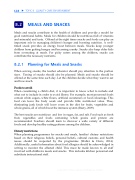Page 142 - HBEC4303_flipTest
P. 142
128 TOPIC 8 QUALITY CARE ENVIRONMENT 8.2 MEALS AND SNACKS
Meals and snacks contribute to the health of children and provide a model for good nutritional habits. Meals for children should be nutritious (full of vitamins and minerals) and tasty. Offered at the right times snacks and foods can play an important role in managing childrenÊs hunger and boosting nutrition. A well- timed snack provides an energy boost between meals. Snacks keep younger children from getting hungry and becoming cranky. Snacks also keep older kids from overeating at meals. For picky eaters among the children, snacks can contribute the necessary nutrients.
8.2.1 Planning for Meals and Snacks
When serving snacks, the teacher educator should pay attention to the portion sizes. Timing of snacks should also be planned. Meals and snacks should be offered at the same time each day. Let the children decide what they want to eat and how much.
Foods to avoid
When considering a child's diet, it is important to know what to include and what not to include in order to avoid illness. For example, most processed foods contain white sugars, white flours, artificial sweeteners or food colourings. This food can leave the body weak and provide little nutritional value. Thus, eliminating junk foods will leave room in the diet for fruits, vegetables and whole grains, all of which boost the immune system (Beaty, 2009).
The best snacks are nutritious and low in sugar, fat, and salt. Food such as fresh fruit, vegetables and foods containing whole grains and protein are recommended. Teachers should learn to discover a wide variety of different foods and develop healthy eating patterns among the children.
Dietary restrictions
When planning programmes for snacks and meals, families' dietary restrictions based on their religious beliefs, personal beliefs, cultural customs and health issues should be respected by the programme (Waller & Davis, 2014). Additionally, useful information about food allergies should be acknowledged in writing to monitor the affected child. This must be made known to all staff involved with children's meals and snacks. This includes kitchen personnel and substitute instructional staff.
Copyright © Open University Malaysia (OUM)


